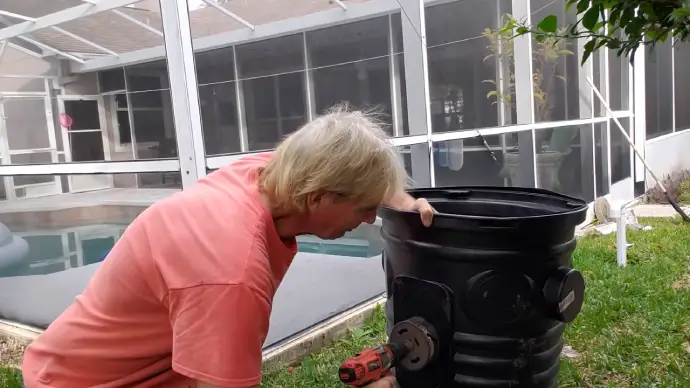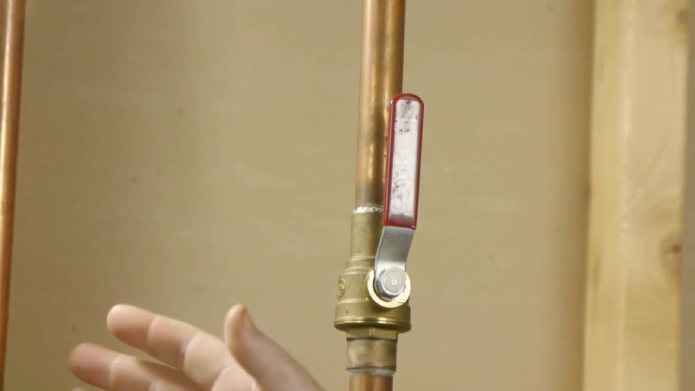Last Updated on July 23, 2023
Sump pump basins are essential to promoting proper drainage and basement waterproofing systems. They collect only water that would otherwise flood the basement and direct it away from the home’s foundation.
But sometimes, the basin may not function correctly, causing water to overflow or the basin to float up. One solution to this problem is to drill holes in the basin. Without holes, water cannot correctly enter the basin effectively, leading to an ineffective sump pump system.
Let’s discuss why holes are essential in sump pump basins and what happens if there are none. You’ll also find out how many holes you should drill in the crock and what size holes to drill.
Should You Drill Holes in Sump Pump Basin: Reasons Why

A sump pump basin collects water that seeps into the basement or crawl space and pumps it out of the house through a sump pump. But if the basin is not properly equipped with holes, it could lead to many problems.
Here are some proper reasons for drilling holes:
Allow Only Water to Enter
A sump pump basin accumulates water from the ground surrounding your home. This water can be contaminated with debris such as leaves, mud, rocks, and other particles. Holes drilled in the basin can help filter out these contaminants, ensuring that only clean water enters the pump.
If these impurities enter the sump pump basin, they can clog the pump, impairing its ability to remove water from the basement. Also, this debris can cause damage to the pump, which can be expensive to repair. Drilling holes allows for proper water filtration and helps extend the lifespan of your pump.
Reduce the Risk of Clogging
A critical aspect of maintaining a sump pump is preventing clogging. When water enters the pump basin, it carries debris and sediment. Over time, these particles can accumulate in the basin and block the pump’s inlet pipes.
If the inlet pipes become blocked, water can’t enter the basin, and the pump won’t activate, causing the basement to flood. Drilling holes in the sump pump basin helps reduce the risk of clogging by allowing water and debris to flow freely without obstructing the inlet pipes.
This means the sump pump will continue operating efficiently and effectively, protecting your home from water damage.
Promote Proper Drainage
Drilling holes in your sump basin also promotes proper drainage. Without drainage, water can accumulate in the basin, creating standing water that can attract pests and foster mildew growth.
Also, standing water can cause a foul odor in the basement, making spending time in your home unpleasant. Drilling holes in the basin allows the water to flow freely, preventing the accumulation of standing water and promoting proper drainage.
Prevent Excess Mud Growth
Over time, the sump basin can become filled with mud, debris, and other materials that can clog up the pump and make it less effective at removing excess water. This can lead to costly repairs or even complete pump failure.
By drilling holes into the basin, you can prevent excess mud growth by allowing water to flow freely into and out of the basin, allowing the pump to function properly. This reduces the amount of debris that gets pumped out, extending the life of your sump pump.
Prevent Airlocks

Airlocks are a common problem with sump pumps. When water enters the sump pit, it pushes air out of the pump, creating an air pocket. This can lead the pump to lose its prime, reducing efficiency and failure.
Drilling openings in the sump pump basin can help prevent airlocks by allowing air to escape from the basin and water to flow more freely. This ensures that the pump is always primed and ready to work when needed.
Increase Pump Lifespan
Sump pumps are not cheap, so taking steps to extend their lifespan is essential. Drilling holes in the basin can help protect the pump by reducing the amount of debris that enters and clogs up the pump.
It also ensures that the pump remains primed and ready for action, preventing damage caused by running it dry. A well-maintained sump pump that works efficiently and lasts for many years, providing peace of mind and protection for your home.
Reduce Basement Flood Risk
If the sump pump malfunctions or is not installed correctly, it can flood your basement. Drilling holes in the sump pump basin is essential to reduce the risk of flooding. The holes allow water to enter the basin from the surrounding soil, preventing pressure build-up that can damage the foundation walls.
Moreover, the holes allow any water outside the basin to enter and be pumped away by the sump pump, preventing any waterlogging risk.
Improve Energy Efficiency
Sump pumps can use vast energy, adding to your home’s carbon footprint and electricity bills. Drilling holes in the sump pump basin enhances the energy efficiency of a sump pump.
Allowing water to enter the pump naturally reduces the need for the pump to work harder than usual. This, in turn, helps reduce the energy it uses, reducing your energy bills and environmental impact.
Maintain a Healthy Environment
A correctly functioning sump pump is essential for maintaining a healthy environment in your home. Without it, high moisture levels can accumulate in the basement, leading to the growth of mold and mildew.
Drilling holes in the sump pump basin allows water from the soil to enter the pump, which helps regulate the basement’s moisture levels. The reduced moisture levels decrease the risk of mold and mildew growth, providing a healthier home environment.
What are the Consequences of Not Having Holes in a Sump Pump Basin?

Sump pump basin holes serve a critical function in the pump’s operation; without them, there could be severe consequences:
Sump Pump Failure
One of the primary consequences of not having holes is the risk of pump failure. When water enters the basin, it begins to fill up. As it reaches a certain level, the pump is activated, pumping water out of the basin through the holes.
However, if there are no holes, the pump will continue to run, but the water won’t leave the basin. This can cause the pump to overheat, burn out, and fail. Without a working sump pump, the basement and foundation risk flooding and water damage.
Clogging with Debris or Sediment
Another danger of lacking holes in your sump pump basin is the potential for clogging. As water enters the basin, it brings with it debris and sediment. Without holes, this material can accumulate and create a blockage, preventing the water from leaving the basin.
Mold and Mildew Growth
Having no holes in a sump pump basin can create the perfect mold and mildew growth environment. When water remains stagnant in a basin, it can become a breeding place for mold spores.
These spores can quickly spread throughout the basement and foundation, causing health problems for home residents. Mold can also lead to structural damage and decreased property value.
Increased Energy Costs
When there are no holes in the basin, the sump pump is constantly working to pump out the water. This means that it is drawing more power, which, in turn, will result in higher energy bills. Also, the wear and tear on the sump pump will be much more substantial than if there were holes in the basin.
Basement Flooding
Without the proper drainage, the water will collect in the basin and eventually overflow, causing water damage in your basement. Basement flooding can also lead to the growth of mold, which can be hazardous to your health. Mold growth can cause respiratory issues, allergic reactions, and skin irritation.
Structural Damage
When water is allowed to accumulate around the foundation, it can cause cracks and weaken the concrete, leading to expensive repairs. Over time, the water can destabilize your home’s foundation, which may eventually make it uninhabitable.
What size holes to drill in a sump pump crock?

When considering drilling holes in the sump pump basin, it’s important to note the size of the holes. It’s recommended that the holes be smaller than the “solids handling rating” of the pump.
This rating is typically between 1/4 inch to 1/2 inch. If the holes are too big, solid particles in the water could pass through and clog the pump, causing damage and costly repairs. Choosing the size of holes is essential to ensure maximum pump efficiency and long-lasting performance.
How many holes should you drill in the sump pump basin?
While it’s necessary to install holes in the basin to allow water to enter, the number of holes and their placement is equally important. Experts suggest drilling six columns of four holes at different heights in the sump pump basin to provide ample access points for water flow.
These holes should be carefully spaced to avoid unintended consequences such as unstable plastic support or significant cracks in the basin’s structure. Strategically placing these holes results in optimized water intake and efficient pump operation.
Can drilling holes in a sump pump basin improve energy efficiency?
Drilling the sump pump basin hole can enhance the pump’s energy efficiency. Ensuring that the pump’s performance is up-to-par saves energy bills and promotes sustainability by reducing power consumption to a minimum.
Also, drilling holes in the basin promotes proper function and enables the pump to run more effectively than without them. Water passing through the holes reduces pressure buildup and allows the pump to work more easily, resulting in more efficient water removal capabilities.
Is it safe and easy to drill holes in a sump pump basin?
Drilling holes in a sump basin is completely safe if you have the proper tools and knowledge. It is crucial to wear personal protective equipment, such as safety goggles and gloves, to prevent any injuries.
Using a power drill with the right drill bit would make the job easier. Remember to drill slowly and carefully, ensuring you do not hit wires or pipes. Lastly, cleaning the basin and removing debris after drilling is essential to avoid clogging.
Should holes be drilled in an existing sump pump basin?

If your existing sump pump basin has no holes, drilling them is highly recommended. Drilling holes in the basin enables water to flow freely into the pump system, preventing it from getting clogged. It also makes removing water from the basin easier for the pump.
Without holes, the basin can accumulate water, affecting the pump’s efficiency as it would have to work harder, resulting in a shorter lifespan. Therefore, it is better to drill openings in the basin and ensure the longevity and effectiveness of your sump pump system.
Protect Your Home: Drill Holes in Sump Pump Basin to Avoid Water Damage
Drilling holes in your sump pump water catch basin can help save you from significant water damage issues. However, before you go ahead and drill holes, make sure you have the necessary tools. Also, check if drilling is permitted and safe without a professional, and think twice before risking the basins’ warranty.
When done appropriately, with the help of an expert, drilling holes in the basin can provide a way for excess water to enter, prevent the basin from floating up, and enable the sump pump to perform its essential job of keeping your basement dry.



